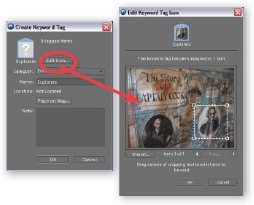Managing Your Files
Organizing your photos with Photoshop Elements
With no film or processing costs to think about each time we take a picture, it seems that many of us are pressing the shutter more frequently than we did when film was king. The results of such collective shooting frenzies are hard drives all over the country full of photos. This is great for photography, but what happens when you want to track down that once in a lifetime shot that just happens to be one of thousands stored on your machine? Well, believe it or not, being able to locate your files quickly and easily is more a task in Organizer management, naming and camera setup than browsing through loads of thumbnails.
Organizing your photos with Photoshop Elements
It starts in-camera
Getting those pesky picture files in order starts with your camera setup. Most models and makes have options for adjusting the numbering sequence that is used for the pictures you take. Generally you will have a choice between an ongoing sequence, where no two photos will have the same number, and one that resets each time you change memory cards or download all the pictures. In addition, many models provide an option for adding the current date to the file name, with some including customized comments (such as shoot location or photographer’s name) in the naming sequence or as part of the metadata stored with the file.
To adjust the settings on your camera search through the Set Up section of the camera’s menu system for headings such as File Numbering and Custom Comments to locate and change the options. Ensure that number sequencing and date inclusion options are switched on and, where available, add these comments along with the photographer’s name and copyright statement to the metadata stored within the picture file. See Figure 4.1.
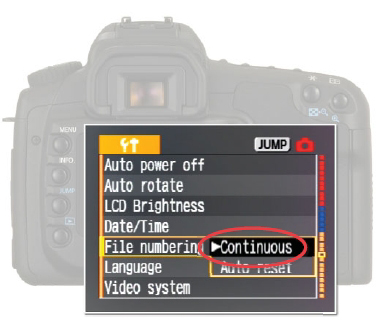
Figure 4.1 Most cameras provide options for selecting the way in which files are numbered. The Continuous option ensures that a new number is used for each picture even if memory cards are changed in the middle of a shoot.
And continues when downloading
As we have already seen Photoshop Elements includes the popular transfer utility that is designed to move pictures from your camera or memory card to the computer. Called the Adobe Photo Downloader, the feature is designed to detect when a camera or card reader is attached to the computer and then automatically transfer your pictures to your hard drive. As part of the download process, the user gets to select the location of the files, apply metadata, auto tag and stack, and select the way that the files are to be named and numbered. See Figure 4.2. For more details on the Adobe Photo Downloader go back to Chapter 3.
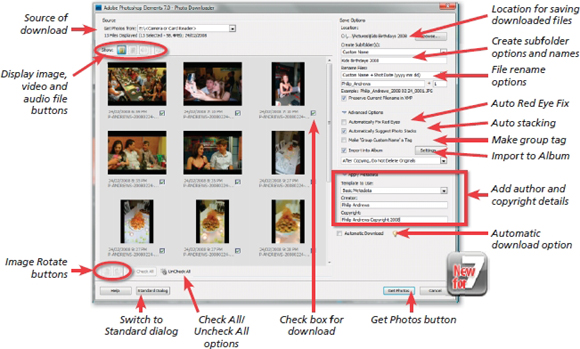
Figure 4.2 The Adobe Photo Downloader that comes bundled with Photoshop Elements allows the user to automatically apply naming changes and to determine the location where transferred files will be saved. In addition, in the Advanced mode (above) images can be auto stacked and tagged with a group name.
It is at this point in the process that you need to be careful about the type of folder or directory structure that you use. Most photographers group their images by date, subject, location or client, but the approach that you employ is up to you. Once you have selected a folder structure though, try to stick with it. Consistency is the byword of photo organization.
If your camera doesn’t provide enough automatic Naming and Metadata options to satisfy your needs then use the Elements Photo Downloader feature to enhance your ability to distinguish the current images from those that already exist on your hard drive by setting the location, group tag, and filename of the picture files as you transfer them. It may also be useful to select the Auto Stack feature as a way of suggesting alike images which can be grouped into Albums or tagged together in the Organizer workspace. New for version 7 is the ability to add downloaded images directly to an album inside the Photoshop Elements Organizer. See Figures 4.3 and 4.4.
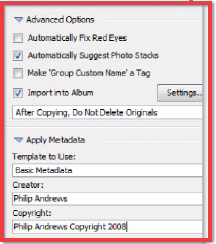
Figure 4.3 Use the options in the Photo Downloader to thoughtfully name, tag, stack and locate your digital photos.
Transferring files with the Photo Downloader
FEATURE SUMMARY
1 Start by connecting the memory card reader or camera/phone to your computer.
2 The Photo Downloader should auto launch when a camera or card reader is attached. If this doesn’t occur then Select File > Get Photos > From Camera or Card Reader. Switch to the Advanced mode.
3 Choose the device where your photos are stored (camera or card reader) from the dropdown list in the Source section of the dialog (top left).
4 Scroll through the thumbnails that are displayed and select images to be transferred and deselect those to be left on the card using the check box on the bottom right of the thumbnail.
5 Choose the location and set the subfolder options in the Save Files section of the dialog.
6 Input a new title into the renaming options.
7 For photographs taken with a flash, select the Automatically Fix Red Eyes option to remove the crimson pupils in your portraits.
8 Click the Get Photos button to transfer the photos and automatically categorize them in the Organizer workspace.
9 Once the files have transferred successfully you will be offered the opportunity to delete the files from the card or camera, freeing up the device for taking more photos.
Advanced organization options with Adobe Photo Downloader
Gradually over the last few releases of Photoshop Elements, Adobe has been adding extra functionality to the Adobe Photo Downloader (APD) utility. The extra features added have been good news for photographers as they help organize your photos by automatically suggesting photo stacks, adding tags and now, with a new feature for version 7.0, even import images into an Elements Album. Let’s look a little closer at each of these features which are located in the Advanced Dialog of the downloader.
Automatically Suggest Photo Stacks
Choosing the Automatically Suggest Photo Stacks in the Advanced Options of the APD instructs Elements to sort through the images as they are downloaded to your computer. What the program is looking for is similarities in picture content and proximity of capture. These photos are then presented back to the user in groups which can be stacked together by simply clicking a single button. So if you have a bunch of images of the same subject shot in quick succession, they will be grouped together and displayed as a possible Photo Stack in the Automatically Suggest Photo Stacks dialog.
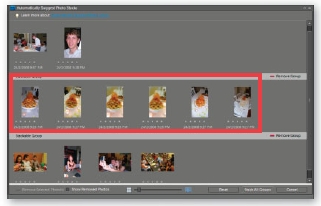
Figure 4.4 Group alike images when transferring your photos by selecting the Automatically Suggest Photo Stacks option in the Adobe Photo Downloader.
Figure 4.5 Once you have sorted the photos into groups, just press the Stack All Groups button to create Photo Stacks in the Organizer.
Images can be added to or subtracted from groups by click-dragging the photos around the dialog. Alternatively, photos that you don’t want stacked can be selected and removed from the process by clicking the Remove Group button. Once you are satisfied with the groupings, pressing the Stack All Groups option will create a Photo Stack in the Organizer workspace. See later in the chapter for more information on creating and using Photo Stacks.
This option is also available when selecting the Get Photos and Videos > From Files and Folders option.

Figure 4.6 To use the group tagging feature start by selecting the Custom Groups (Advanced) item.
Make Group Custom Name a Tag
Another image management option available at the time of download is the ability to add a tag to groups of photos. Tags, which are also referred to as Keyword Tags in Photoshop Elements, are a set of descriptive words attached to pictures that can used to help locate specific photos in large Catalogs. Generally Tags are added to photos in the Organizer workspace (see the next section in this chapter for more details) but the Make ‘Group Custom Name’ a Tag option in APD allows you to add a tag when downloading. Using this feature is a three step process (see Figure 4.6):
1. Select the Custom Groups (Advanced) option in the Create Subfolders area. Use the slider control to adjust the number of photos included in each group.
2. Choose the Custom Name option from the Group Name drop down menu.
3. Ensure that the ‘Make Group Custom Name a Tag’ option is selected in the APD dialog.
4. Click on the tag name entry (called Custom Name by default) on the title bar of each group and type in a new Tag name. Click Get Photos to download the files and add the new Tag names to groups.
Individual photos can be excluded from the download and tagging process by unchecking the tickbox at the bottom right of the thumbnail. After setting up and selecting the Get Photos button, APD downloads the photos, creates new tag entries and then attaches these tags to the selected photos.
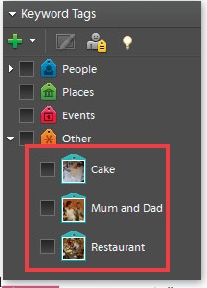
Figure 4.7 Tags are automatically added and applied using this feature.

Figure 4.8 Automatically add photos to Albums using the new Import into Album option.
Import into an Album
New for Photoshop Elements is the ability to add photos to Albums as they are transferred from camera card to computer. After selecting the Import Into Album option in the Advanced dialog of the Adobe Photo Downloader, pressing the Settings button displays the Select an Album window where you can choose which Album to add the photos to. The window also contains buttons to add new tags, edit the name of tags and delete tags. The edit and delete options are only available when selecting empty Albums that have been added in the window. After setting up a new Album for the download, clicking OK will close the Settings window and Get Photos will download the pictures and add them to the new Album. See Figure 4.8.
Organizing and searching features
The Organizer workspace not only provides thumbnail previews of your photos but images can be categorized with different tags (keywords), notes and caption entries, split in different Albums (Collections) and then searched for based on the tags and metadata associated with each photo. Also, photos that are alike in appearance or subject matter can be stacked or grouped together. Unlike a traditional browser system, which is folder based (i.e. it displays thumbnails of the images that are physically stored in the folder), the Elements Organizer creates a catalog version of the pictures and uses these as the basis for searches and organization. With this approach it is possible for one picture to be a member of many different albums and to contain a variety of different keywords. See Figure 4.9.
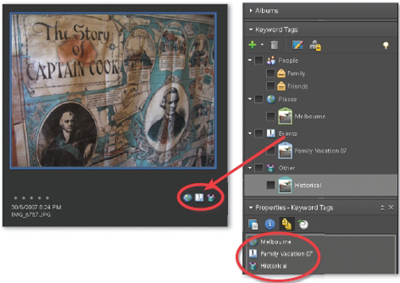
Figure 4.9 Keyword Tags and Albums (previously called Collections) are used to organize the pictures in the Organizer workspace. One photo can belong to many different Albums and contain multiple tags but is only stored once in the catalog.
Tagging your photos
From version 6, Keyword entries became Keyword Tags. As before, these simple descriptors can be added to your photos and used to help organize your images. The Keyword Tags panel stores the tags, provides an easy drag and drop approach to adding tags to selected photos, and sits to the right of the main thumbnail area in the Organizer workspace. The pane is grouped together with the Albums panel in the new Task pane (Window > Show Task Pane) and was previously called the Organize Bin. Tags are applied to a picture by selecting and dragging them from the panel onto the thumbnail or, alternatively, the thumbnail can be dragged directly onto the Tags pane. Multiple tags can be attached to a single picture by multi-selecting the tags first and then dragging them to the appropriate thumbnail.
FEATURE SUMMARY
1 To add a tag to a single image click and drag the tag from the Keyword Tags panel to the thumbnail image in the Organizer workspace.
2 To add a single tag to multiple thumbnails, multi-select the thumbnails in the images and then drag the tag from the Keyword Tags panel onto one of the selected thumbnails.
Creating new keyword tags
New keyword tags are created and added to the panel by selecting the New Tag option from the menu displayed after pressing the ‘+’ button at the top left of the panel. Next, fill out the details of the new entry in the Create Keyword Tag dialog, select a suitable icon for the tag label and click OK. See Figure 4.10.
Figure 4.10 You can add to the existing set of tags using the New Tag option. There is even an option to add your own pictures as the tag icon.
FEATURE SUMMARY
1 To create a new keyword tag, select the New Keyword Tag option from the ‘+’ button menu at the top of the Tags panel.
2 In the Create Keyword Tag dialog select a category for the new tag, add in a name and include any explanatory notes.
3 Next, press the Edit Icon button and select a picture to include with the tag label before sizing and cropping the photo in the Edit Tag Icon dialog.
4 Click OK to close both dialogs and add the new keyword tag to the tag list.
Face Tagging technology
The ability to search through a group of photos and automatically select those that contain faces was first introduced in Elements 4.0. Using this feature makes it much easier to locate and tag photos of family and friends in the batches of pictures that you import. Start by selecting a group of photos from inside the Organizer workspace. Next, click the Find Faces for Tagging button in the Keyword Tags panel. The faces identified will be displayed in a new dialog box which also includes the Keywords Tags panel. See Figure 4.11. From here your tags can be quickly dragged onto individual or groups of selected face photos.
FEATURE SUMMARY
1 Multi-select a group of images from inside the Organizer workspace.
2 Either choose Find > Find Faces for Tagging or press the Find Faces for Tagging button at the top of the Keywords Tags panel.
3 Drag tags onto the pictures that are displayed in the Face Tagging dialog. Click Done to return to the Organizer workspace.

Figure 4.11 The Face Tagging option quickly scans a group of selected photos and identifies those pictures that contain faces and displays these in a separate dialog ready for tagging.
Albums – the Elements way to group alike photos
Apart from tagging, Photoshop Elements also uses Albums (previously called Collections) as a way to organize your photos. Albums allows you to group images of a similar theme together in the one place, making it easier to locate these images at a later date. Another benefit is that the images contained in an album can also be ordered manually. After creating an album in the Albums pane, photos are simply dragged from the Photo Browser workspace to the Album heading to be added to the group. In Elements 7.0 you can share albums online, create photo books, burn them onto CD/DVD discs, email them to friends, and sync them online to photoshop.com.
The Albums feature allows you to allocate the same image to several different groups. Unlike in the old days with simple folders-based systems, this doesn’t mean that the same file is duplicated and stored multiple times in different folders; instead, the picture is only stored or saved once and a series of Album associations is used to indicate its membership in different groups. When you want to display a group of images based on a specific subject, taken at a particular time or shot as part of a certain job, the program searches through its database of Album entries and only shows those images that meet your search criteria. The Albums panel is the pivot point for all your Album activities. Here you can view, create, rename and delete Album entries. See Figure 4.12.

Figure 4.12 Sort your pictures into groups of the same subject or theme using the Elements Albums feature. (1) Albums panel.
Adding photos to an Album
To start using Albums make a new album first and then add it to your photos.
FEATURE SUMMARY
1 Start by making a new album by clicking on the ‘+’ button in the Albums panel and selecting the New Album menu item.
2 In the Album Details dialog choose the group that the new album will belong to, add the name and include any explanation details for the group. Click OK.
3 Select the photos to be included in the album in the Organizer and drag them to the Items area in the Albums panel. Then click Done.
4 To view all the pictures contained in an album click on the Album heading in the Albums panel.
5 Single photos or even groups of pictures can be added to more than one album at a time by multi-selecting the album names first before dragging the images to the pane.
Adobe introduced a new album type in Photoshop Elements 6 called Smart Albums. Images are included in a Smart Album based on one or more search criteria established at the time that the album is created. Each time the Smart Album entry is selected Elements automatically adds any new photos that meet the criteria to the group. Smart Albums are a great way to keep important collections of images up to date without the need to manually find and add images to the album. See Figure 4.13. You can create Smart Albums either via the New Smart Album entry in the new album pop-up menu (click the ‘+’ button at the top of the panel to display), or by executing a search using the Find > By Details (Metadata) feature. Both avenues provide the user with the chance to choose the search criteria used for the basis of the Smart Album. With the Find > By Details option, it is necessary to select the Save this Search Criteria as Smart Album setting at the bottom of the dialog before starting the search. It should be noted that Smart Albums can’t be synchronized.

Figure 4.13 After setting up, clicking the Smart Album entry will automatically search for, and include, any new images to the Album.
Establishing search criteria
The idea of setting up specific search criteria as the basis of creating a Smart Album may seem a little daunting, but the range of possibilities included in the search dialog, either New Smart Album, or the Find by Details, makes the process as simple as selecting options from several drop-down menus. With the dialog open, start by choosing if the photos need to contain any, or all, of the search criteria to be included in the album. Obviously for single criteria searches this isn’t an issue, but the dialog allows the user to add several criteria (click the ‘+’ button at the right end of the criteria entry) for searching. Next, create the basis for the search by selecting the criteria. In the example in Figure 4.14 pictures are included if their rating is higher than three stars.
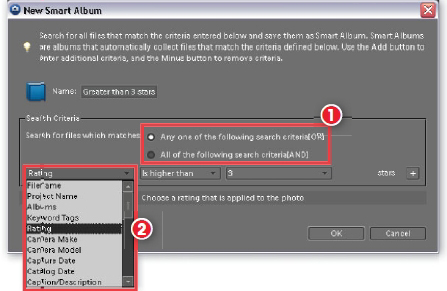
Figure 4.14 To set up the search criteria used for a Smart Album pick the matching option first (1) and then the criteria from the drop-down menus (2).
There are no less than 30 different criteria that can be used for the search. These include most camera settings (sometimes called EXIF data) such as lens, ISO, F-stop and Shutter Speed, individual photo details including file size, pixel dimensions and filename as well as Elements-specific criteria like keyword tags, project name, version set, project type or even map location. Once you are comfortable with creating search criteria, the whole Smart Album system provides a very powerful and efficient way to locate groups of images in your catalog.
Creating a new Smart Album
There are three ways to create Smart Albums in Elements. The first is via the options in the Album panel. See Figure 4.15.
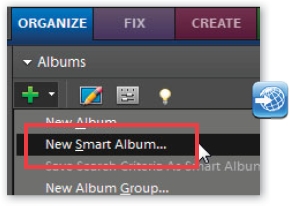
Figure 4.15 To create a Smart Album choose the New Smart Album from the menu access via the ‘+’ button at the top of the Albums panel.
FEATURE SUMMARY
1 Start by selecting the New Smart Album entry from the menu displayed by clicking on the ‘+’ button in the Albums panel.
2 Next, add in a name for the album in the text box at the top of the New Smart Album dialog.
3 Choose how the files will match the criteria. You can select between matching any of the criteria or all of the criteria.
4 Now start with the drop-down menu on the left of the dialog and select the criteria group to use for the search, i.e. Filename, Project Name, Keyword Tags, Camera Model, etc.
5 Depending which entry you choose in the first menu the number of menus (and their content) on the right will change accordingly. The entries in these menus are designed to refine the search. For instance, if you choose the Project Type as your main search criteria then you will have a second menu containing Gallery, Photobook and Slideshow.
6 With one criteria established you can add other criteria by clicking the ‘+’ button on the right of the Search entry. This displays a new search criteria menu set.
Using Find to make Smart Albums
The second way to create Smart Albums in Elements is to use the search abilities in the Find > By Details (Metadata).
FEATURE SUMMARY
1 Select the By Details (metadata) entry from the Find menu to display the Find by Details dialog. Input the match option and search criteria in the same way as outlined in steps 3–6 above.
2 Next, select the Save this Search Criteria as Smart Album option at the bottom of the dialog. This makes the Name text box active. Add a title for the New Smart Album here. See Figure 4.16.

Figure 4.16 You can also create a new Smart Album using specific search criteria detailed in the Find > By Details (Metadata) feature.
Smart Albums via the new Search feature
The Adobe guys decided to include a new Search feature in the shortcuts bar at the top of the Organizer workspace. Like other such features typically found in computer operating systems this dedicated search box provides a speedy way to locate images based on a text entries associated with an image. This information may be stored in the filename, as a keyword or as part of the EXIF data for the photo.
Elements refines the results of the search as you type. Locating pictures in this way has the added bonus that the search term that you employed can be used to create a new Smart Album.
FEATURE SUMMARY
1 Start by typing the search term into the new text box located on the left of the Shortcuts bar. You may need to try a range of different search terms.
2 Once the correct photos are displayed in the Organizer workspace choose the Save Search Criteria As Smart Album entry from the Options menu, See Figure 4.17.

Figure 4.17 Use the criteria input into the new search feature as the basis of a new Smart Album.
Converting Keyword Tags to Smart Albums
The last way to create Smart Albums is to use existing Keyword Tags as the basis for creating a new Smart Album.
FEATURE SUMMARY
1 After clicking the Keyword Tag entry to display the images containing the tag, choose the Save Search Criteria As Smart Album entry from the Options menu at the top left of the workspace. See Figure 4.18.

Figure 4.18 Click onto the Keyword Tag entry to display the pictures with the associated keyword then choose the Save Search Criteria As Smart Album entry from the Options menu.
Using Album Groups
Different albums (and the photos they contain) can also be organized into groups that have a common interest or theme. For instance, albums that contain pictures of the kids, family vacations, birthday parties and mother and father’s days events can all be collated under a single ‘Family’ Album Group heading.
Figure 4.19 Album Groups are used to help organize Albums with common themes under one heading.
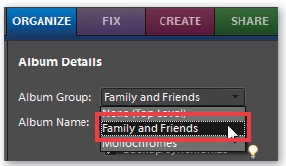
Figure 4.20 Add new Albums to existing Groups by selecting the Album Group entry in the Album Details pane.
Create an Album Group by selecting the New Album Group entry from ‘+’ menu in the Albums panel. Next, click and drag existing album entries listed in the pane to the group heading. After creating an Album Group you can add any new Albums to the group by selecting the group entry from the Album Group drop down menu in the Album details pane. See Figures 4.19 and 4.20.
Album and Keyword Tagging strategies:
The best way that you choose to make use of the Tagging and Album features in Elements will depend a great deal on the way that you work, the pictures you take and the type of content that they include, but here are a few different proven methods that you can use as a starting point.
Subject:
Photos are broken down into subject groups using headings such as family, friends, holidays, work, summer, night shots, trip to Paris, etc. This is the most popular and most applicable approach for most readers and should be the method to try first.
Timeline:
Images are sorted and stored based on their capture date (when the picture was photographed), the day they were downloaded or the date that they were imported into the organizational package. This way of working links well with the auto file naming functions available with most digital cameras but can be problematic if you can’t remember the approximate dates that important events occurred. Try using the date approach as a subcategory for subject headings, e.g. Bill’s Birthday > 2005.
File type:
Image groups are divided into different file type groups. Although this approach may not seem that applicable at first glance it is a good way to work if you are in the habit of shooting raw files which are then processed into PSD files before use.
Project:
This organizational method works well for the photographer who likes to shoot to a theme over an extended period of time. All the project images, despite their age and file type, are collated in the one spot, making for ease of access.
Client or Job:
Many working pros prefer to base their filing system around the way that their business works, keeping separate groups for each client and each job undertaken for each client.
Locating files
One of the great benefits of managing your pictures in the Organizer workspace is the huge range of search options that then becomes available to you. In fact there are so many search options that Adobe created a new menu heading ‘Find’ specifically to hold all the choices. See Figure 4.21. Here you will be able to search for your photos based on a selected date range, filename, caption, media type (video, photo, audio or creation), history (when an item was emailed, printed, received, imported, used in a creation project or even shared online) and even by the predominant color in the photo.
After selecting one of the Find menu options Elements either displays files that meet the search criteria in a new window (Find by Version Sets, Media Type, Untagged Items, Items not in a Album) or opens a new dialog where the user must enter specific details (dates, filenames, details, captions) which will be used to base the search. See Figure 4.21.
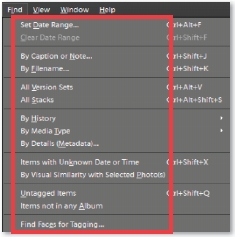
Figure 4.21 The Find menu in the Organizer workspace lists the many different ways to locate images within Elements.
Finding tagged photos or those contained in an Album
As well as the search options located in the Organizer: Find menu, you can make use of the Tags and Albums features to quickly locate and display sets of photos from your catalog.
To find tagged photos: Click the Keyword Tag entry in the Keyword Tags panel. See Figure 4.22.
To display all the images in an album: Click on the Album entry in the Albums panel.
To return the browser back to the original catalog of thumbnails: Click on the Show All button (previously Back to All Photos) at the top of the thumbnail group. See Figure 4.24.

Figure 4.22 To display all images tagged with a specific entry click the Keyword Tag or Album name in the Keyword Tags or Albums panel.

Figure 4.23 When choosing the Date Range, Caption or Note, Filename (see above), History and Details find options Elements displays a new dialog into which your search criteria can be entered.

Figure 4.24 Press the Show All button (previously Back to All Photos) to return to displaying the images in the full catalog after conducting a search.
As we have already seen in passing, the Find option is designed to allow users to search the details or metadata that are attached to their picture files. Most digital cameras automatically store shooting details from the time of capture within the photo document itself. Called metadata, you can view this information by clicking the Metadata button inside the Properties palette.
The Find > By Details (Metadata) option displays a sophisticated search dialog that allows you to nominate specific criteria to use when looking within the metadata portion of the picture file. The dialog provides a section to input the text to search for as well as two drop-down menus where you can set where to look (Filename, Camera Make, Camera Model, Capture Date, etc.) and how to match the search text (Starts with, Ends with, Contains, etc.). See Figure 4.25.
Beyond camera-based metadata you can also use this dialog to search for any captions, notes, tags or albums that you have applied to your pictures.
FEATURE SUMMARY
1 Select Find > By Details (Metadata) from the Organizer workspace.
2 Select the match option – any or all.
3 Choose the type of details that you are looking for – Filename, Camera Make, Camera Model, etc. – from the drop-down list in the Find by Details dialog.
4 Enter the text you want to search for (if needed).
5 Enter how the search text should appear in the located files (contained, not contained, etc.)
6 Also included is the ability to save the Find settings that you input here as the search criteria for a Smart Album.
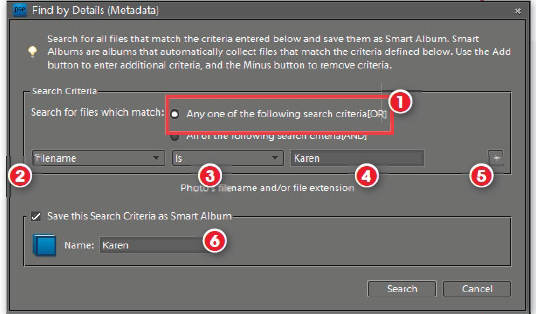
Figure 4.25 The Find by Details feature allows you to customize the search options used via settings within the dialog. Start by selecting how the criteria will be matched (1). Choosing the type of detail to look for from the drop-down list (2) determines the contents of the rest of the dialog. In this instance selecting ‘Filename’ displays a second list (3) describing how to match the text you input (4). Extra search criteria can be added or removed by pressing the Plus or Minus buttons to the right of the dialog (5). Also included is the ability to save the search criteria as a Smart Album (6).
First released in version 5.0 was the ability to link map references with the photos in your organizer catalog. This feature provides a new way to reference and locate your photos. See Figure 4.26. The mapping technology is provided in association with Yahoo and one of the ways that you can share your map referenced picture is via the company’s popular photo sharing site www.flickr.com.
To create a map reference for a photo, drag and drop the thumbnail from the main Organizer workspace onto the Map pane (below left). If the Map panel is not shown then select the Show Map option from the Display menu on the right of the shortcuts bar. Or use the Place on Map command from the Context menu or Edit menu to type in a location. This approach can be more accurate than dragging the photo to a map. To reference a group of photos, tag these images first and then drag the tag to the map. Both these actions will place a pin on the map to indicate that there are photos linked with this area. To view photos associated with a map reference click on a pin with the Hand tool. Alternatively, to display all the photos associated with the current map, select the Limit Search to Map Area option in the tool bar below the map display.
The referenced maps you create, and their linked photos, can be shared online by uploading either to your own website using the Photo Galleries feature or to www.Flickr.com.

Figure 4.26 Elements includes a Map feature which provides the ability to associate photos in the Organizer with points on an interactive map. After making the link, clicking the map pin with the Hand tool will display a pop-up window of the associated photos.
Protecting your assets
Ensuring that you keep up-to-date duplicates of all your important pictures is one of the smartest work habits that the digital photographer can learn. Ask yourself ‘What images can’t I afford to lose – either emotionally or financially?’ The photos you include in your answer are those that are in the most need of backing up. If you are like most image makers then every picture you have ever taken (good and bad) has special meaning and therefore is worthy of inclusion. So let’s assume that you want to secure all the photos you have accumulated.
Gone are the days when creating a backup of your work involved costly tape hardware and complex server software. Now you can archive your pictures from inside the very software that you use to enhance them – Photoshop Elements.
The Back up feature (Organizer: File > Back up Catalog to CD, DVD or Hard Drive) is designed for copying your pictures (and catalog files) onto DVD, CD or an external hard drive for archiving purposes. To secure your work simply follow the steps in the wizard. The feature includes the option to back up all the photos you currently have cataloged in the Photo Browser along with the ability to move selected files from your hard disk to CD or DVD to help free up valuable hard disk space. See Figure 4.27.
FEATURE SUMMARY
1 To start the back up process Select File > Back up Catalog to CD, DVD, or Hard Drive from the Photo Browser workspace.
2 Next, select Full Back up for first time archiving or Incremental Back up for all back ups after the first one. Click Next.
3 And, finally, select the place where you want the back up to be stored. This may be on a series of CDs or DVDs or on an internal drive, and then click Done to back up your files.
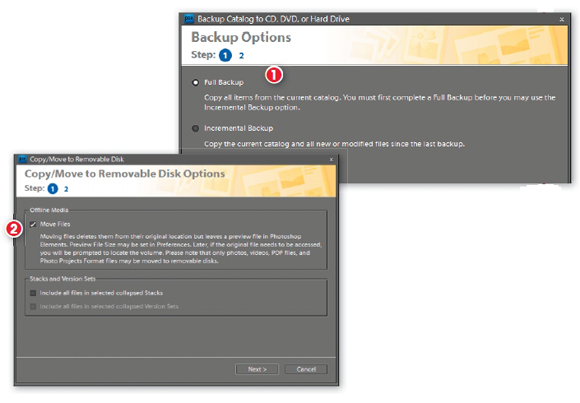
Figure 4.27 Unlike the previous version of Elements, in versions 6 and 7 the backup files and Copy/Move Files functions have been separated into two different dialogs. To back up files select the File > Back up Catalog to CD, DVD, or Hard Drive option. To copy or move files choose the File > Copy/Move to Removable Disk entry.
(1) Back up Catalog – This option provides a complete backup of all the files in your catalog and then the next time it is used allows you to add any files that have been changed or added since the last back up.
(2) Copy/Move Files – Use this selection to make copies of files that you have selected in the Photo Browser workspace or to permanently move files to another destination.
With the the Back up Catalog feature it is also possible to archive your catalog over a series of CD or DVD disks. Multiple disk options like this are sometimes referred to as ‘disk spanning’.
In earlier versions, the Back up feature only allowed writing to a single disk and, even with the growing use of DVD-ROMs for archive scenarios, many digital photographers have a catalog of photos that far exceeds the space available on a single disk.
The revised Back up feature estimates the space required for creating the backup copy of the catalog and, after selecting the drive that will be used for archiving, the feature also determines the number of disks required to complete the action. See Figure 4.21. During the writing process the feature displays instruction windows at the end of writing each disk and when you need to insert a new disk. All disks need to be written for the back up to be complete. To restore a catalog from a set of back up disks use the File > Restore Catalog option in the Organizer workspace.

Figure 4.21 Elements includes the ability to back up the Organizer catalog across multiple disks.
Multi-session Back up
As well as providing the ability to back up large catalogs over multiple disks, the revised Back up feature also allows multi-session recording of archives. Multi-session DVD or CD-ROM recording means that you can add extra back up files to disks that you have already recorded to. This means that if you only fill a quarter of the storage space of a DVD disk when you first create a back up, you will be able to write to the non-used area in a later back up session. Most Elements users will find this useful when performing incremental back ups.
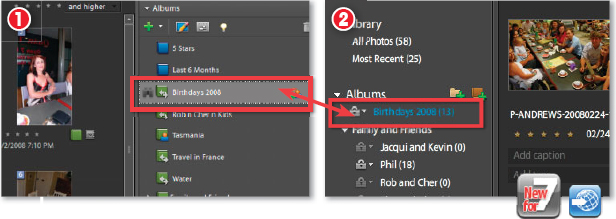
Figure 4.22 The new Backup/Synchronization feature in Elements stores exact copies of selected files on both the photoshop.com (2) website and in the Elements Organizer (1).
Online Backup and Synchronization
An online archive option was available in previous versions of Photoshop Elements. Called Online Back up (Organizer: File > Online Back up), the feature has now been replaced with a more sophisticated system linked with photoshop.com. Rather than provide a process that requires users to remember to backup their files on a regular basis, the Adobe guys have put in a place a synchronization model. This means that, once set up, the pictures you have sitting on your computer at home are duplicated on the photoshop.com website and vice-versa. Making a change to a picture either online using the website features or via Elements, results in an updated version being stored in both locations. See Figure 4.22. Cool!

Figure 4.23 Version 7 now includes the ability to synchronize the photos stored in Albums in Elements to space on the photoshop.com website. This feature is a sophisticated form of archiving which ensures that the albums on your computer are always the same as those stored online.
Rather than synchronizing your whole Photoshop Elements Catalog, the new synchronization system uses Albums which are common to both photoshop.com and the Organizer. As we have already seen in passing (in the last chapter) the Welcome screen in version 7 contains a series of new online options that are available to registered Elements users. One of these options is titled Backup Settings. See Figure 4.23. Clicking this entry will display the Backup/Synchronization section of the Elements’ Preferences dialog. This window can also be displayed by selecting the Preferences entry from the Edit screen in the Organizer workspace or by clicking the Backup/Synchronization preferences button at the top of the Albums pane.
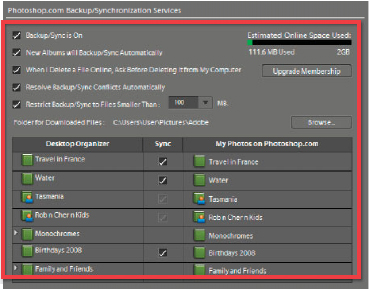
Figure 4.24 The options for the new backup feature are grouped together in the Backup/Synchronization Services section of the Photoshop Elements Preferences.
The settings contained here allow you to turn the synchronization feature on and off, choose for all new albums to synchronized online by default, options for resolving synchronization conflicts and scenarios when you delete photos online as well as maximum size files included in the synchronization process. The dialog also provides a visual summary of the albums that are currently stored in both locations and whether they are synchronized, a space usage meter and the option to upgrade your membership to access more backup space and exclusive Elements tips and techniques. See Figure 4.24.
When the backup/synchronization feature is active on your computer a new icon is added to your system tray. Called the Sync Monitor, right-clicking on the icon will display several options which indicate the current status of the feature. If the Pause or Stop entries are shown, then the sync system is currently active. Choosing the Backup/Sync only when Idle option restricts update activity (which occurs via an active internet connection) to times when the connection is not being used by other programs such as a web browser or email program. See Figure 4.25. There is also another version of the Sync Monitor located in the bottom left of the Organizer workspace. Here there are options for viewing backup, not backed files as well as those that are waiting (‘pending’) to be backup. Chapter 12 contains more details about the features available at photoshop.com.

Figure 4.25 Rick-click on the Sync Monitor icon in the system tray to display settings for the feature.
Back up glossary:
Multi-disk archive – A process, often called spanning, by which chunks of data that are larger than one disk can be split up and saved to multiple CD-ROMs or DVDs using spanning software. The files can be recompiled later using utility software supplied by the same company that wrote the disks.
Full back up – Duplicates all files even if they haven’t changed since the last time an archive was produced.
Incremental – Backs up only those files that have changed since the last archive was produced. This makes for faster back ups but means that it takes longer to restore files as the program must look for the latest version of files before restoring them.
Restore – Reinstates files from a back up archive to their original state on your hard drive.
Back up hardware:
CD-ROM or DVD writer – This option is very economical when coupled with software that is capable of writing large numbers of files over multiple disks. The sets of archive disks can easily be stored off-site, ensuring you against theft and fire problems, but the back up and restore process of this approach can be long and tedious.
Internal hard drive – Adding an extra hard drive inside your computer that can be used for backing up provides a fast and efficient way to archive your files but won’t secure them against theft, fire or even some electrical breakdowns such as power surges.
External hard drive – Connected via USB or Firewire these external self-contained units are both fast and efficient and can also be stored off-site, providing good all-round protection.
Back up regularly
There is no point having duplicate versions of your data if they are out of date. Base the interval between performing manual back ups on the amount of work you do. In heavy periods when you are downloading, editing and enhancing many images at a time back up more often; in the quieter moments you won’t need to duplicate files as frequently. Most professionals back up on a daily basis or at the conclusion of a work session. Alternatively add the pictures used in your current projects to an Album with the Backup/Synchronization feature switched on. It should be noted that synchronization is not instantaneous, especially for large files.
Store the duplicates securely
In ensuring the security of your images you will not only need to protect your photos from the possibility of a hard drive crash but also from such dramatic events as burglary and fire. Do this by storing one copy of your files securely at home and an extra copy of your archive disks or external backup drives somewhere other than your home or office. Synchronised Albums account for such events by storing their contents both in Elements and also online.
Creating a good archival system goes a long way to making sure that the images you create are well protected, but what about the situation where the original photo is accidentally overwritten as part of the editing process? Embarrassing as it is, even I have to admit that sometimes I can get so involved in a series of complex edits that I inadvertently save the edited version of my picture over the top of the original. For most tasks this is not a drama as the edits I make are generally non-destructive (applied with adjustment layers and the like) and so I can extract the original file from inside the enhanced document but sometimes, because of the changes I have made, there is no way of going back. The end result of saving over the original untouched digital photo is equivalent to destroying the negative back in the days when film was king. Yep, photographic sacrilege!
So you can imagine my relief to find that in last few versions of Photoshop Elements Adobe featured a technology that protects the original file and tracks the changes made to the picture in a series of successively saved photos. The feature is called Versioning as the software allows you to store different versions of the picture as your editing progresses. What’s more, the feature provides options for viewing and using any of the versions that you have previously saved. Let’s see how this file protection technology works in practice.
Versions and Photoshop Elements
Versioning in Elements extends the idea of image stacks by storing the edited version of pictures together with the original photo in a special group or Version Set.
All photos enhanced in the Organizer space using tools like Auto Smart Fix are automatically included in a Version Set. Those images saved in the Quick and Full editor spaces with the Save As command can also be added to a Version Set by making sure that the Save with Original option is ticked before pressing the Save button in the dialog. See Figure 4.26.

Figure 4.26 To create a Version Set when saving an edited file from inside the Quick or Standard editor workspace make sure that the Save in Version Set with Original option is selected.
Saving in this way means that edited files are not saved over the top of the original; instead, a new version of the image is saved in a Version Set with the original. It is appended with a file name that has the suffix ‘_edited’ attached to the original name. This way you will always be able to identify the original and edited files. The two files are ‘stacked’ together in the Organizer with the most recent file displayed on top.

Figure 4.27 The bundled photos icon at the top right of the thumbnail indicates that the photo is part of a Version Set.

Figure 4.28 Selecting the Version Set > Expand Items in Version Set option from the right-click menu displays the various pictures that have been bundled together in the set.
When a photo is part of a Version Set, there is a small icon displayed in the top left of the Photo Browser thumbnail. The icon shows a pile of photos. See Figure 4.27 on previous page.
To see the other images in the version stack simply click the sideways arrow on the right of the thumbnail or right-click the thumbnail image and select Version Set > Expand Items in Version Set. See Figures 4.28 and 4.29. Using the other options available in this pop-up menu the sets can be expanded or collapsed, the current version reverted to its original form or all versions flattened into one picture. Version Set options are also available via the Photo Browser Edit menu. Only the top most photo in a version set is synchronized, but all photos in a stack are synchronized online.

Figure 4.29 The Expand and Collapse buttons are positioned to the right of the thumbnail of standard image stacks as well as Version Sets.
Elements’ photo stacks
A photo stack is slightly different from a Version Set as it is a set of pictures that have been grouped together into a single place in the Organizer workspace. Most often stacks are used to group pictures that have a common subject or theme and the feature is one way that Elements users can sort and manage their pictures. To create a version stack, multi-select a series of thumbnails in the workspace then right-click on one of the selected images to show the menu and from here select the Stack > Stack Selected Photos option. The photo you right-click on will be the top photo in the new stack. See Figure 4.30. You can identify stacked image groups by the small icon in the top right of the thumbnail. See Figure 4.31.
Figure 4.30 Photo stacks use a layered photos icon in the top right of the thumbnail to indicate that the picture is one of several images that have been grouped together. All photos in a stack are synchronized.

Figure 4.31 To manually group alike photos into an photo stack, multi-select the pictures in the Photo Browser workspace before choosing Stack > Stack Selected Photos from the right-click menu.
Auto stacking
The idea of grouping together alike photos in a single stack was introduced in version 3.0 of the program. Elements also contains the ability to auto stack images as they are downloaded from camera, imported into Elements from folders or even when displayed in the Organizer workspace. The feature looks for images that are visually similar, or were captured within a short time interval, when suggesting groups of images that are suitable for stacking.
You can employ the Elements Auto Stacking feature in a couple of different ways:
Photos in the Organizer – To auto stack pictures already in your catalog select a group of thumbnails and then choose Automatically Suggest Photo Stacks from either the Edit > Stack or the right-click pop-up menus. See Figure 4.32.
Photos being imported – To stack when importing choose the Automatically Suggest Photo Stacks option in the Get Photos and Videos dialog.
Either of these two options will then display a new window with alike pictures pre-grouped. Choosing the Stack All Groups button converts the groups to stacks.
The Remove Group button prevents the group of pictures being made into a stack.
1 To automatically stack alike photos that have already been imported into the Organizer start by multi-selecting pictures from the Photo Browser.
2 Next right-click one of the thumbnails and choose Stack > Automatically Suggest Photo Stacks from the menu that is displayed.
3 Elements will then show you a new screen containing the groups of images that it suggests should be stacked. Click the Stack All Groups option to convert the groups to stacks.
4 To stop a set of pictures becoming a photo stack press the Remove Group button before conversion.
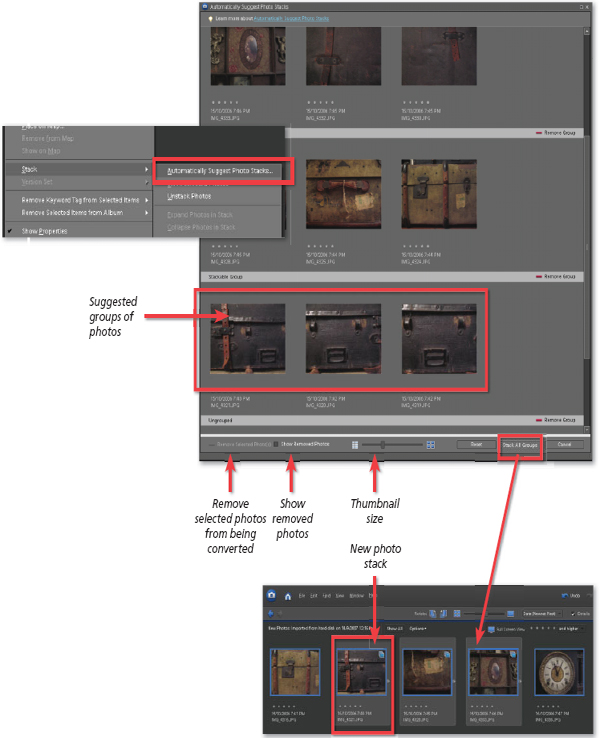
Figure 4.31 The Stack > Automatically Suggest Photo Stacks option displays groups of images that can be converted to photo stacks with the click of a single button.


